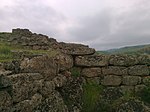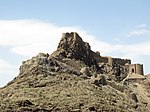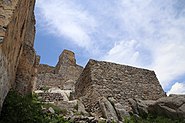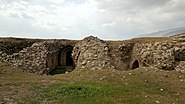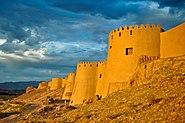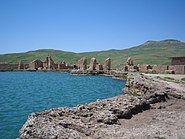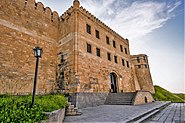Atashgah Castle
| Atashgah Castle | |
|---|---|
قلعه آتشگاه | |
 Atashgah Castle is one of the castles of in Iran | |
 Location within Iran | |
| General information | |
| Status | Ruined |
| Type | Castle |
| Architectural style | Sasanian |
| Town or city | Kashmar |
| Country | Iran |
| Coordinates | 35°18′59″N 58°23′10″E / 35.31639°N 58.38611°ECoordinates: 35°18′59″N 58°23′10″E / 35.31639°N 58.38611°E |
| Technical details | |
| Structural system | Defensive |
| Part of a series on Shīa Islam
Isma'ilism |
|---|
 |
|
|
Atashgah Castle (Persian: قلعه آتشگاه) is a castle in the city of Kashmar, and is one of the attractions of Kashmar. This castle was built by the Sasanian government and it was famous in ancient times.[1][2]
Location[]
The location of the castle is strategically interesting. This fort is one of the most prominent and superior ancient forts of Iran in terms of inaccessibility and resistance against invaders and easily competes with the fortifications of Babak Fort in Kaleybar and Alamut Castle in Alamut. This shows that the builders of the castle have carried out extensive field studies to locate it. In total, Atashgah Castle is built on a high rocky cliff and difficult to cross, three sides of which are high and dangerous precipices. Around this cliff, shortly after the precipices, the walls of other high cliffs have re-enclosed it in the form of impenetrable and inaccessible fortifications.[3]
Laneh Muri[]
Laneh Muri is a term for some kind of underground defensive structures. These structures are now known by one of the lesser-known letters "cave /shelter /castle / hole / underground city" or other similar terms.[4] These structures, which have been seen in many parts of Iran And Turkey, are winding corridors and corridors with several floors and labyrinths Which is made in imitation of the ant nest. The plot of these nests was so complex, nested, and dark that if the enemy or a stranger or unfamiliar person entered, he would get lost in the dark corridors and eventually be killed by the natives or by thirst and hunger and lack of air.[3]
Fire Temple of Kashmar[]
According to the Paikuli inscription, during the Sasanian Empire, Kashmar was part of Greater Khorasan, and the Sasanians worked hard to revive the ancient religion. It still remains a few kilometers above the ancient city of Kashmar in the castle complex of Atashgah.[5]
Kashmar Fire Temple was the first Zoroastrian fire temple built by Vishtaspa at the request of Zoroaster in Kashmar. In a part of Ferdowsi's Shahnameh, the story of finding Zarathustra and accepting Vishtaspa's religion is regulated that after accepting Zoroastrian religion, Vishtaspa sends priests all over the universe And Azar enters the fire temples (domes) and the first of them is Adur Burzen-Mihr who founded in Kashmar and planted a cypress tree in front of the fire temple and made it a symbol of accepting the Bahi religion And he sent priests all over the world, and commanded all the famous men and women to come to that place of worship.[6]
Gallery[]
See also[]
- Atashgah Manmade-Cave
- Sasanian Empire
- Adur Burzen-Mihr
Sources[]
- ^ "Atashgah castle". www.itto.org. Retrieved 31 July 2019.
- ^ "Irania Encyclopedia (Persian)". Irania Encyclopedia. Archived from the original on 2019-06-07. Retrieved 2019-06-06.
- ^ a b "لانهموری و قلعه آتشگاه کاشمر". ghiasabadi.com. Retrieved 4 February 2021.
{{cite web}}: CS1 maint: url-status (link) - ^ "لانه موری (پناهگاه زیرزمینی، شهر زیرزمینی) - فرهنگنامه ایران". irania.ir. Archived from the original on 23 October 2020. Retrieved 4 February 2021.
- ^ "ترشیز؛ دروازه ورود اسلام به خراسان". khorasan.iqna.ir. Retrieved 11 October 2020.
- ^ "تاریخچه و نقشه جامع شهر کاشمر در ویکی آنا". ana.press. Retrieved 27 October 2020.
{{cite web}}: CS1 maint: url-status (link)
- Iranian castle stubs
- Buildings and structures in Razavi Khorasan Province
- Buildings and structures in Kashmar
- Castles in Iran
- Ruined castles in Iran
- Sasanian castles
- Tourist attractions in Razavi Khorasan Province
- Castles of the Nizari Ismaili state
- Sasanian architecture












